AI often gets pitched as the cure for everything, but most advice for AI in management is vague. You know that weekly meeting that eats two hours and could’ve been an email? That’s exactly where AI should help with cutting wasted hours and speeding up decisions.
That’s why we keep it straightforward at Aloa. We build AI applications that fit how your team already works. We help clear out admin clutter, sharpen insights, and turn data into actionable insights that save money without breaking your flow.
Here’s what you’ll get from this guide:
- Why artificial intelligence in management matters now
- How companies use AI in daily operations
- Seven benefits of AI you can actually measure
- A step-by-step way to roll out AI and prove ROI
We’ll show you how AI creates value and how you can apply it without wasting budget or patience.
How AI in Management Is Changing the Game
AI in management helps managers cut busywork through process automation, make sense of data, and act faster. It supports planning, hiring, reporting, and daily decisions, so leaders spend less time in spreadsheets and more time leading with facts.
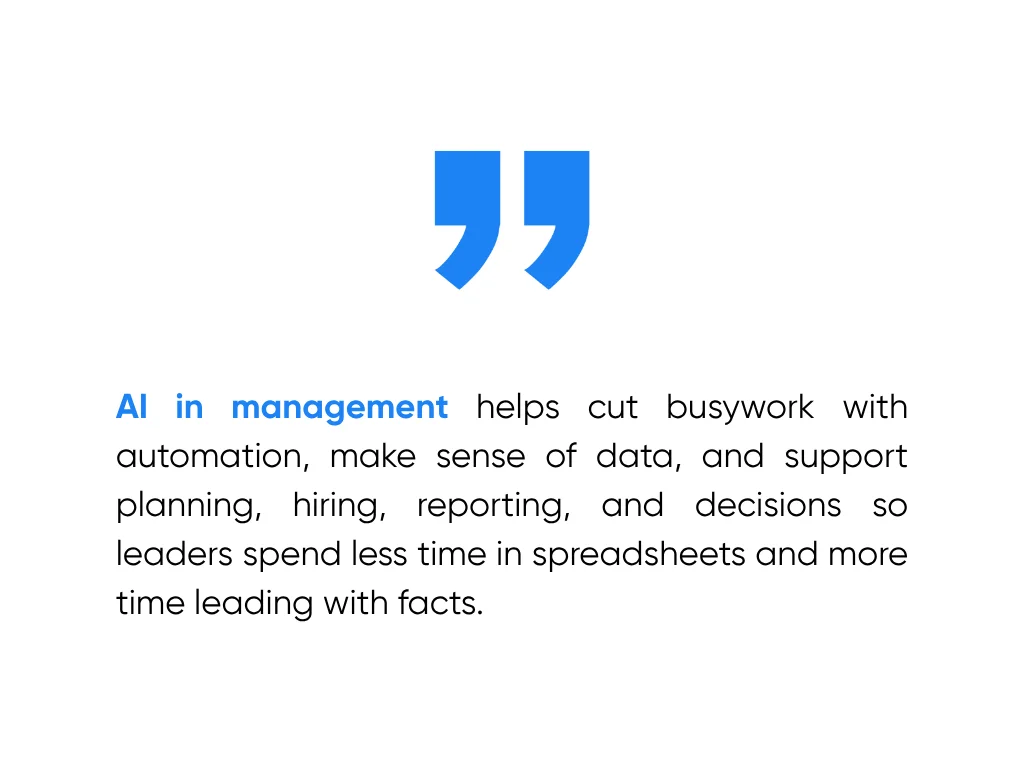
Let’s be honest, nobody wakes up thinking, “You know what I need today? Another chart.” Managers need clarity. If a project is slipping or a team is stretched too thin, you shouldn’t burn half a day digging through reports. With AI, you ask the question in natural language and get a straight, data-backed answer in seconds.
For mid-sized businesses, that shows up in:
- Dashboards that give straight answers: Instead of bouncing between ten systems, you see one screen that says, “Project X is two weeks behind because approvals stalled.” Less guessing, more doing
- Virtual assistants that handle routine tasks: Auto-approving small expenses, booking recurring meetings, or knocking out those “can you check this?” requests. Hours saved each week, and no one has to babysit admin work.
- Alerts that flag problems early: A ping that tomorrow’s clinic schedule is overloaded or overtime costs are creeping up. You catch it before it turns into a fire drill.
Here’s the part that doesn’t get enough airtime: AI isn’t here to shove managers aside; it’s raising the bar. Research from IESE Business School shows demand for managers is climbing, but the role is changing. The best leaders aren’t buried in raw data; they can read the signals, explain them in plain language, and move their teams to act on them.
That puts a premium on human skills like data literacy, human judgment, emotional intelligence, and communication. Recent updates show more companies training managers not just to use AI tools, but to translate what the tools say into decisions people can trust. The irony is, the more AI we add, the more the human side of leadership becomes the edge.
To see where this is already working, take a look at these AI use cases and benefits.
Real World Applications of Artificial Intelligence in Management
When you hear “Google, Tesla, Amazon,” it’s easy to think, “Yeah, but we’re not them.” Fair. Their scale is massive. But the way they use management artificial intelligence isn’t about being huge. It’s cutting friction and making smarter calls faster. And those lessons scale down just fine. Let's take a look:
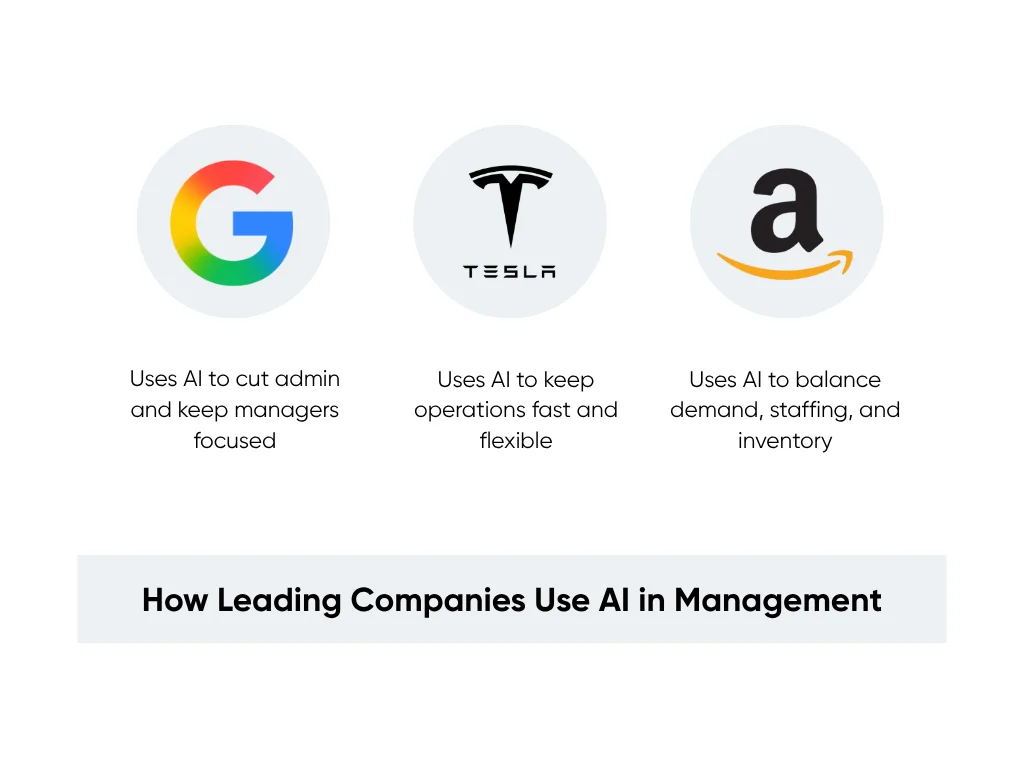
Google uses AI to strip out the little frictions that keep managers buried in admin instead of leading. Here’s how:
- Workload Balancing: AI spots who’s overloaded and who has bandwidth, then redistributes tasks. It saves leaders from the dreaded “Who can take this?” email.
- Meeting Recaps: Google Meet uses AI to spit out decisions and action items as soon as the call ends. No more “Didn’t we already cover this?” loops.
- Knowledge Search: Instead of digging through folders, managers ask a plain-English question (like “What’s our Q3 hiring target?”) and the answer just shows up.
This results in faster decisions, tighter alignment, and fewer repetitive meetings. Even for small to mid-sized teams, you can use auto-generated notes to free up hours each week. With the right internal tooling, AI can amplify the tools your team already uses.
Tesla
Tesla uses AI for:
- Anomaly Detection: Sensors stream large volumes of data nonstop. AI flags unusual equipment patterns before they become stoppages. More “quiet heads-up” than fire drill.
- Predictive Scheduling: Forecasts show when a robot arm or line will need attention, and schedules adjust in advance. It’s like a planner who never sleeps.
- Dynamic SOPs: Processes evolve in real time as machine learning updates what works. If a tweak improves output today, tomorrow’s checklist already reflects it.
This is real-time management in action: decisions made closer to the work, and playbooks that adapt as conditions change. For mid-sized teams, it can be as simple as mining CRM or system logs for recurring hiccups, setting up alerts tied to task assignments, and letting workflow automation turn those alerts into next steps.
Amazon
Amazon runs on AI now: From warehouses to customer service, AI helps managers juggle demand, staffing, and inventory:
- Adaptive Staffing: Forecasts predict order spikes and flex schedules automatically across business functions. Extra shifts are slotted in before crunch time, and slack shifts shrink when things slow.
- Inventory Optimization: Predictive models track sales patterns and market trends to keep supply chain management smooth. Managers get ahead of shortages instead of scrambling.
- Feedback Loops: AI digests delivery times, error rates, and customer feedback, then feeds improvements back into staffing and processes. What works, sticks.
Smaller orgs can apply these in a lighter form: tie staffing to demand forecasts, add inventory dashboards to spot trends early, and use retrieval-augmented generation so floor managers can pull up SOPs in chat instead of digging through binders.
You can also explore AI companies on the rise reshaping enterprise tech to see how emerging players are driving similar change.
7 Benefits of Using AI in Management
Google, Tesla, and Amazon show what AI can do at scale, but you certainly don’t need their budgets to see results. AI can bring clear benefits to any team. Here are the seven benefits that matter most:
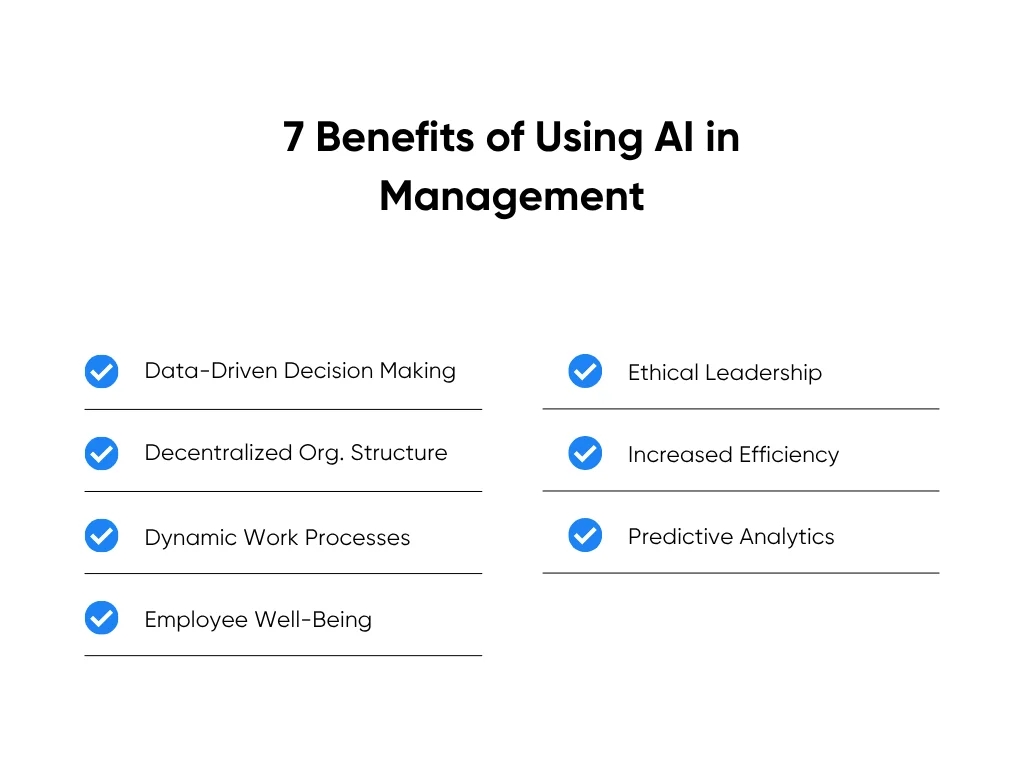
1. Data-Driven Decision Making
AI takes the guesswork out of management by automating data analysis across vast amounts of data to surface valuable insights. Instead of five different numbers floating around, you finally get one version of the truth. And it even tells you how confident it is.
That revenue forecast that used to burn an hour arguing over whose Excel was “right”? Now it’s a ten-minute check-in. The dashboard pulls clean numbers, highlights trends, and generative AI explains questions like “How’s Q3 looking by region?” in plain English. The debate disappears, and the decision actually gets made.
Use forecast error and decision cycle time as your gauges. Data-and-AI leaders aren’t just guessing better. They’re 81% more efficient vs. 58% of peers. That’s the difference between endless debate and decisions that stick.
2. Decentralized Organizational Structure
AI lets decisions move closer to the front line without losing oversight. HQ sets the rules, but local managers finally get the AI capabilities to act in the moment.
Take a store manager adjusting prices. Instead of waiting days for corporate sign-off, an AI copilot shows demand patterns, checks if the change fits the guardrails, and logs it automatically. Ask, “Is this price shift in range?” and you get the answer on the spot. No bottlenecks, no email chains disappearing into the void.
Track rollout speed and margins. If changes hit faster and profits hold steady, you know authority is finally sitting where it belongs.
3. Dynamic Work Processes
Static SOPs are like stale bread. By the time you get to them, they’re already useless. AI keeps processes alive, adjusting as new data rolls in.
Support teams feel this every holiday season. Ticket volume doubles, managers scramble, and triage rules are already outdated. With AI, priorities flex automatically: VIP tickets to senior reps, FAQs to bots that handle routine customer queries, edge cases flagged for humans. Less guessing, more solving.
Watch average handle time, first-contact resolution, and customer satisfaction. If tickets close faster and customers stop circling back, the system’s doing its job.
4. Employee Well-Being
AI doesn’t replace human workers; it takes the grind off their plates. Managers and staff keep the judgment calls, while the software handles repetitive admin.
Meeting notes, scheduling, data entry, form-filling: it’s the admin glue nobody brags about but everybody dreads. Hand it to AI technology and suddenly managers get back a couple of hours a week. That’s two hours less copy-paste, two hours more coaching your team, or two hours actually making it home for dinner.
Check eNPS and attrition. If the mood’s lighter and people stick around, AI’s doing its job. Daily AI users, by the way, report 34% higher job satisfaction worldwide.
5. Ethical Leadership
AI doesn’t have to be the cold “computer says no.” Built right, it makes leadership feel fairer by being transparent and accountable to ethical standards and data privacy.
Take expense approvals. An AI bot waves through anything under $500 but logs the rationale every time. If someone disagrees, they can appeal (an auditable use of AI that reduces potential risks). And that’s not replacing judgment; it’s showing the receipts so people trust the system.
Audit pass rates and incident counts are your gauges. Cleaner audits and fewer flags mean AI’s building trust, not eroding it.
6. Increased Efficiency
AI helps you get more done with the same team by automating low-value touches. Humans still handle judgment calls, but the routine stuff runs on rails to streamline business processes.
Expense approvals are the classic example of process automation that lowers human error. Under $500? Cleared instantly. Over that? Sent to a manager. For finance teams buried under reports, that’s hours of clicking gone every week. Scale it across departments, and you’re saving days.
Track cycle times and cost per transaction. If they’re dropping without your headcount climbing, efficiency’s paying off.
7. Predictive Analytics
Most managers spend their week firefighting. Predictive AI spots the smoke before the fire. It blends historical data with live signals to warn you about risks (or opportunities) you’d normally miss.
Subscriptions dipping? AI sees churn coming. Instead of waiting for cancellations, those customers hit a “save offer” queue. Some get a discount, some get support, and revenue that would’ve walked stays put. Same play in ops: catch equipment failures or supply gaps before they snowball.
The metric to watch is prevented incidents or customer saves. If you’re putting out fewer fires and keeping more customers, predictive analytics is earning its keep.
How to Implement Artificial Intelligence in Management
Benefits look good on paper, but you don’t run your business on theory. The real question is where AI fits into your management today, whether it’s cutting admin work, sharpening forecasts, or spotting risks before they hit. Here’s how AI can help you right now:
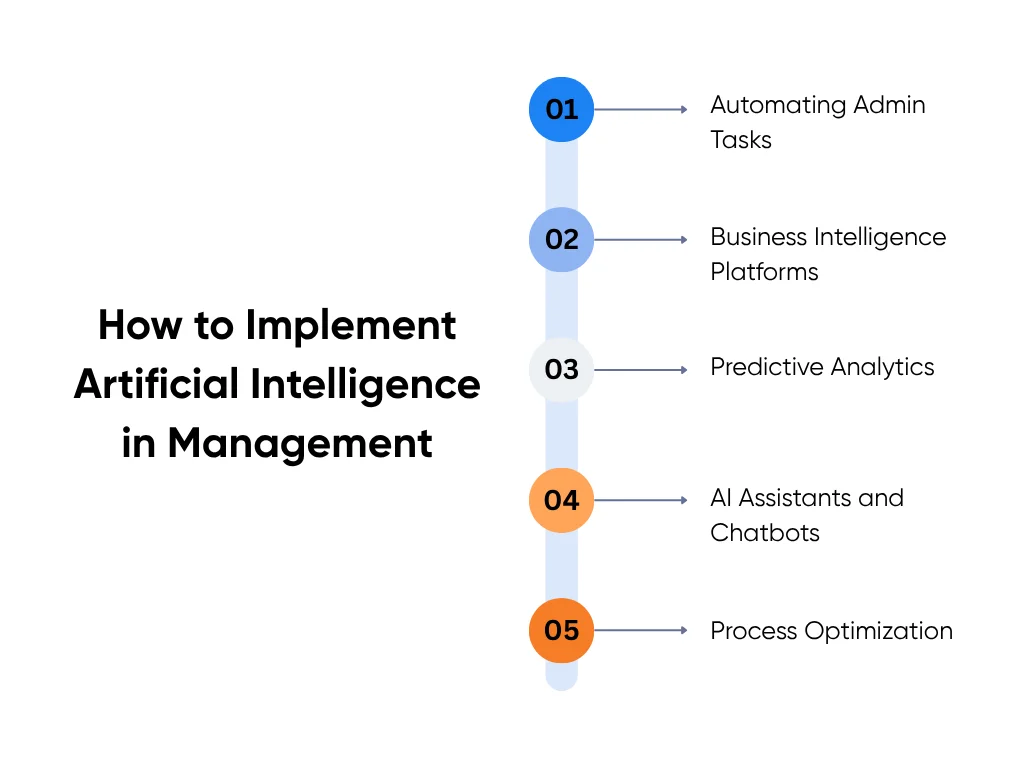
- Automating Admin Tasks: Schedules meetings, writes recaps, clears low-value approvals, and enters data. You get hours back to coach your team and focus on strategy.
- Business Intelligence Platforms: Pulls data into one clear dashboard. You see accurate forecasts and live answers without juggling spreadsheets.
- Predictive Analytics: Scans patterns and real-time signals to flag churn, staffing gaps, or supply delays. You get to act early instead of cleaning up late.
- AI Assistants and Chatbots: Answer routine questions, route requests, and handle FAQs to boost customer engagement. And your team gets faster support, and you avoid constant interruptions.
- Process Optimization: Rewrites workflows as conditions change across business models. AI updates SOPs and routes tasks automatically so your team keeps moving forward instead of following yesterday’s rules.
Rolling out AI isn’t about chasing shiny tools. Start with one workflow that matters, prove ROI, then scale your AI adoption. That’s where Aloa helps you cut through the noise, plug AI into tools you already use, and roll it out in a way that sticks.
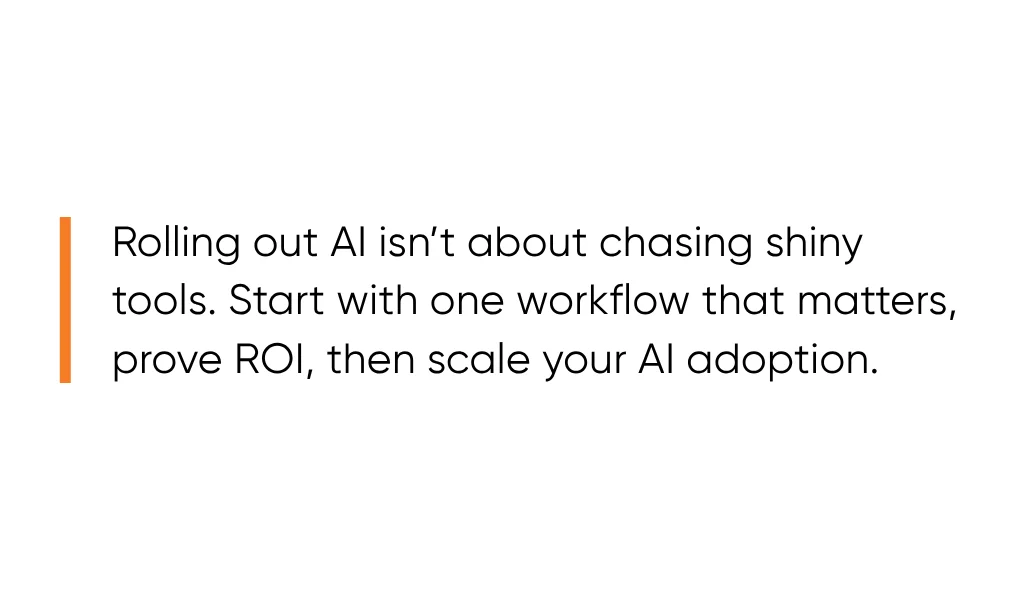
If you’re operating at enterprise scale, you may also find 7 proven ways to transform your enterprise with AI useful for a deeper dive into big-organization use cases.
Key Takeaways
AI in management helps cut wasted hours, reduce admin drag, and make decisions faster without driving up costs. But the smart move is to start small: pick one workflow, run a 90-day pilot, and measure if it saves time or money. If it does, double down. If it doesn’t, you’ve lost little and learned a lot. That’s how operators under cost pressure bring AI into the real world.e real world.
At Aloa, we help you do exactly that: build AI that fits your workflow, proves ROI quickly, and scales only when it makes sense. If you’re ready to get your first pilot running, book a consultation and improve your internal processes with AI-powered solutions.
FAQs About AI in Management
How does artificial intelligence benefit businesses?
AI cuts wasted time by automating tasks like customer support, lead scoring, and reporting. It also analyzes data at scale to uncover patterns humans might miss. The result? Lower admin costs, more accurate forecasts, and more bandwidth for your team to focus on growth.
How does AI help business intelligence?
AI improves business intelligence by consolidating data into clean dashboards, spotting trends, and producing forecasts automatically. Instead of reconciling conflicting spreadsheets, managers get a single source of truth. That means faster decisions and fewer errors.
What are the advantages and disadvantages of AI in management?
AI in management streamlines workflows, reduces overhead, and improves the quality of decisions. Managers can scale operations more efficiently without adding extra headcount. But the downsides are just as real. Poor data produces poor outcomes, and bias or errors can creep in if models aren’t properly tested. Costs can also rise if the scope isn’t well defined, and teams often need change management to address concerns about automation.
How is AI redefining Leadership and Management?
AI is shifting management from oversight to enablement. Leaders use it for faster decision cycles, real-time collaboration, and operational agility. The best results come when managers combine human skills (judgment, empathy, vision) with AI-powered insights.
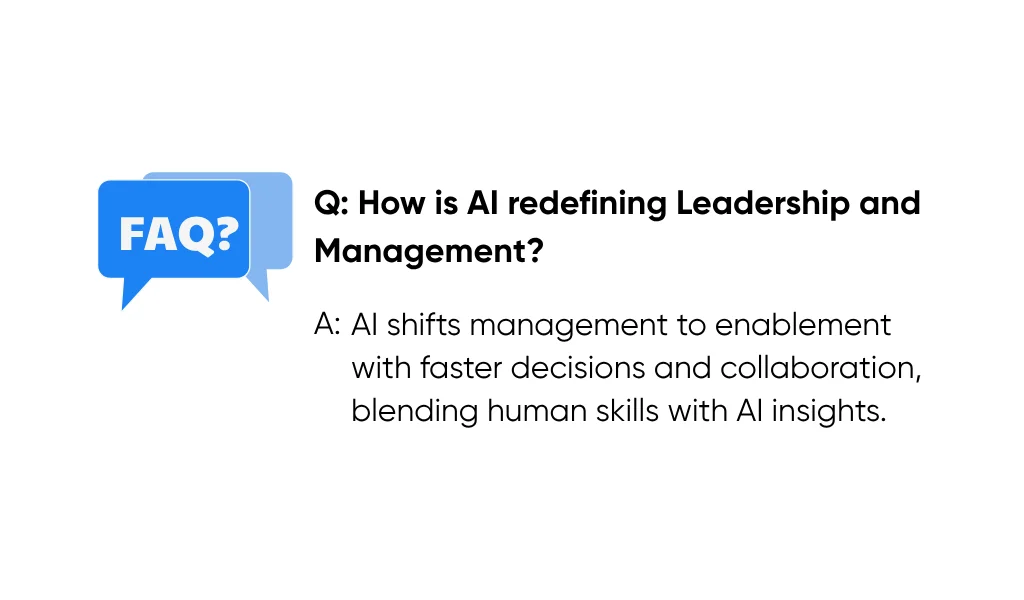
What are the ethical considerations of AI in management?
Responsible AI in management requires transparency (explain how decisions are made), privacy (protect user data and get consent), and safety (AI systems must not cause harm). Bias testing, human oversight, and clear accountability are also essential. Practical example: an AI that auto-approves expenses should log every decision and allow appeals.

